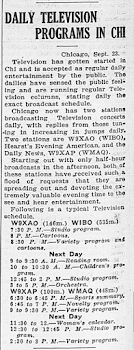 There was a time when it was a big deal to see someone’s feet on television.
There was a time when it was a big deal to see someone’s feet on television.
Long before networks, in the days of mechanical television (roughly 1928-1933), about all a camera could do was sit there while a square of hot lights beamed at someone’s head and shoulders.
A television station in Chicago aimed to change all that.
In 1929, W9XAO (operated by radio’s WIBO) began telecasting. Add another year and add another Chicago TV station.
Both the New York Times and Herald Tribune radio sections ran feature stories on July 13 about the coming station. We’ll skip the Times story; the Herald Tribune’s has about the same content. (The photo below, right, is from the Times; the two pictures after the article have been cleaned up from the Trib.)
Sight Transmitter Installed In Station WMAQ Studio
———
Transmit Images on Low Wave Band and Sound on Regular Channel; Two Receivers Needed, Undergoing Tests Prior to the Opening.
———
CHICAGO, July 12.—By the end of the week Chicago will have television programs through the new station of “The Chicago Daily News,” it was learned today. The station, which will operate jointly with WMAQ as the sound channel, has virtually been completed, and is now undergoing a series before regular programs are inaugurated.
Televised images will be transmitted through the experimental station, W9XAP, on a frequency of 2,800 kilocycles, and with a power of 1,000 watts.
Simultaneous sound accompaniment will be sent through station WMAQ and listeners equipped with both television and radio receivers will be able to both see as well as hear entertainment as it is broadcast from the special television studio of station WMAQ.
Two Receivers Necessary
It was pointed out, however, that in order to receive both the sight and sound broadcasts, it is necessary to have two radio receiving sets, the customary broadcast receiver for sound and a short-wave receiver for television, and in addition, the television equipment which connects to the short wave receiver in much the same manner as the loud speaker joins to the broadcast receiver.
The television station involves the latest developments in sight transmission, it is said. Heretofore the transmission of images of persons has been confined largely to the head and upper shoulders.
 The apparatus at W9XAP, it is said, will transmit a full-length picture of several artists at once.
The apparatus at W9XAP, it is said, will transmit a full-length picture of several artists at once. Through the use of a double scanning arrangement, developed by the designers of the apparatus, the Western Television Corporation, it is possible for the operator to adjust the lenses of the television camera into focus for any number of entertainers, the studio was designed and built to provide for the presentation of television-radio plays, for dramatic skits, and for acts in which action and symmetry of motion might interest the listener.
Unlike the usual broadcasting studio, the television room will be practically dark, in order to permit the light beam which scans the objects to react on the sensitive “eye” of the television camera. Variations in lightness and darkness are obtained through a narrow beam of light which literally paints the television subject and which records their intensity on the sensitive element of a photo-electric cell. This cell converts the light impulses into electrical impulses, which are transmitted as modulated tones over the television transmitter.
An unusual feature of the television apparatus is the use of mirrors attached to the television camera, which enables the control operator to follow the artists broadcasting to any part of the studio. This arrangement is employed because of the bulkiness of the television apparatus and eliminates the necessity for the subjects to remain directly within the limited focus area of the television lens.
Four projection lenses mounted on a turret on each of the two scanners make it possible to record a group of full length, and an instant later to show close-ups of each artist. This gives extreme flexibility.
Technical Details
The scanning disk revolves at 900 revolutions a minute synchronous with the sixty-cyc1e lighting circuit, it was explained. It has forty-five tiny holes arranged in three 120 degree spirals, so that scanning is accomplished by three offset scans down the field a revolution. The three spiral method of scanning is used to eliminate flickering, and la said to register action better than a single spiral.
Two huge photo-electric cells sixteen inches in diameter are suspended from the ceiling of the studio, on a track arrangement, and provide the artist pick-up. The track arrangement permits proper location for pick-up in any part of the studio. The announcer’s pick-up is entirely separate and distinct from that of the artists. Mounted on his table is a ring-bank of eight 6-inch photo cells. Each of the three pick-up units in the studio, the ring-bank of eight cells, and the two large cell units, has a three-tube amplifier as an integral part which builds up the feeble television impulse for transmission to the “mixer” and thence to the main amplifier in the operating room, where it is modulated for transmission over the station.








No comments:
Post a Comment